Taylor White’s kinetic, overscale work is changing the face of downtown Raleigh
by Colony Little | photography by Geoff Wood
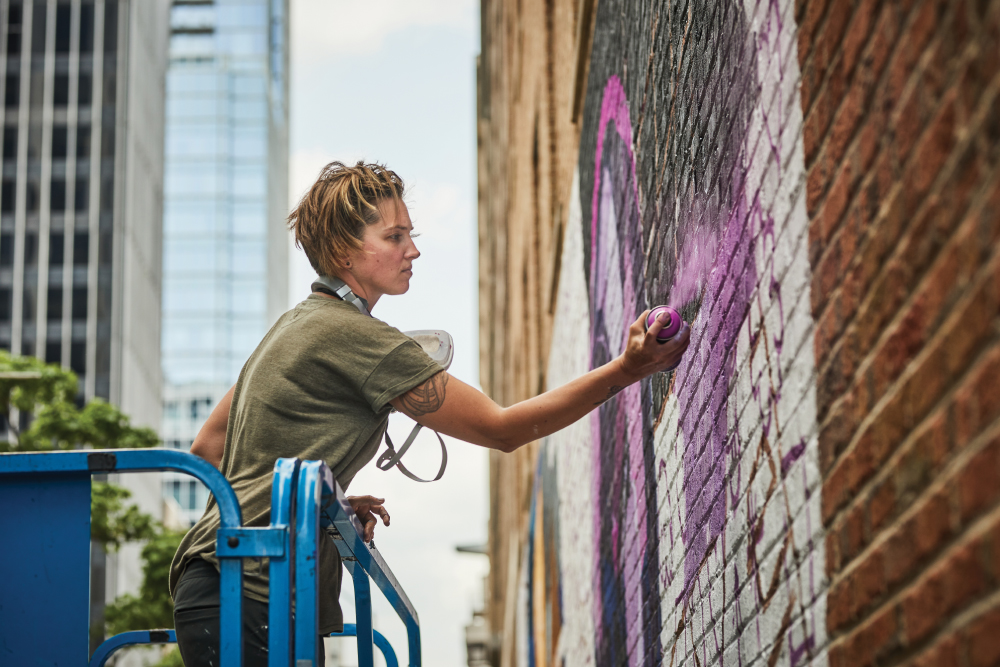
For as long as Taylor White can remember, she’s had a paintbrush in hand. She started by replicating her favorite characters in books, like the delicately drawn charcoal animals in Robert McCloskey’s Make Way for Ducklings and the hyperstylized, fantastical characters found in cartoons and comic books. Even her teachers noticed her talents at an early age: at 5 years old, she landed her first commissioned gig, creating a flyer for her kindergarten circus at Kingswood Elementary School in Cary.
Art continued to weave its way into White’s life. She took advanced art classes in middle and high school, where her influences evolved into surrealist artists like Salvador Dalí. She moved to Georgia to attend the Savannah College of Art and Design, where she studied illustration. “SCAD is pretty career-oriented,” White says, “so I was always of the mindset of, How am I going to make a living this way?”
When she graduated from SCAD she moved to Norway and took a job as a storyboard artist for an advertising company. But over time she questioned her career choice; there was little creative freedom in her full-time work. “I’d planned to be a commercial artist, but I did that for three years and then was like, I’m not sure about this,” she says. While she was working in commercial advertising, White kept up her personal illustration, where she continued to cultivate her artistic voice. Her early illustrations walk the line between figurative and surrealist imagery depicting whimsical characters, oftentimes children, who are both at play and in peril. Her style combined hints of McCloskey’s charcoal shading with strong lines of black ink against a soft palette of pastel yellows, greens, and dusty rose.
While in Norway, her personal work caught the eye of an art patron, who saw potential in White. “I was doing a lot of illustration work but the energy of my work was more fine art, and he was like, I’m curious to see what you would do if I gave you a show,” she says. He invited her to participate in a group exhibition that would ultimately change the trajectory of her career from commercial illustration to painting.
However, by the late 2000s, Norway’s economy was struggling through a recession, and White found herself without a job. At the urging of a friend, the artist packed her bags and moved again, this time to Melbourne, Australia. “It was another one of those serendipitous moments,” says White. “I was talking to a friend from college and I said I was going to leave Norway but don’t know what I’m going to do next. She said, I have a ticket to Australia, I leave after Christmas, you should come. That’s all it took.”
That nudge was all she needed to take a leap of faith, with the hope that a move to a new country would reignite her career. While in Australia, White continued to hone her artistic voice while working odd jobs to pay expenses. She began sketching surrealist ink portraits that explored her childhood. Her work from this period is introspective and expresses the complex emotions that emerge out of direct and indirect trauma. “My home life was very stable, but there’s always something that will throw you for a loop,” says White. “I had some experiences with turmoil that was reflected in that work in an exploratory way, so you see some of the childhood emotions.”
Using vintage reference images from child labor documentary photographer Lewis Hine, White sketched children in newsboy caps and button-up shirts whose faces were scratched out in magenta or aqua green ink. “They depict a side of childhood that people don’t want to talk about,” says White. “It’s not all cartoons and innocent experiences. Your world is always shifting.”
White’s time in Australia also coincided with the zenith of Melbourne’s street art scene. She networked her way into a group of supportive artists who showed her the ropes of mural-painting, and they helped her scale up her illustrations. Soon, many of the children in her sketches found their way onto Melbourne’s walls. “Melbourne was very embracing — there wasn’t a lot of tribalism,” White says. “It was like, you’re good at art, let’s do art together. It was a great environment.”
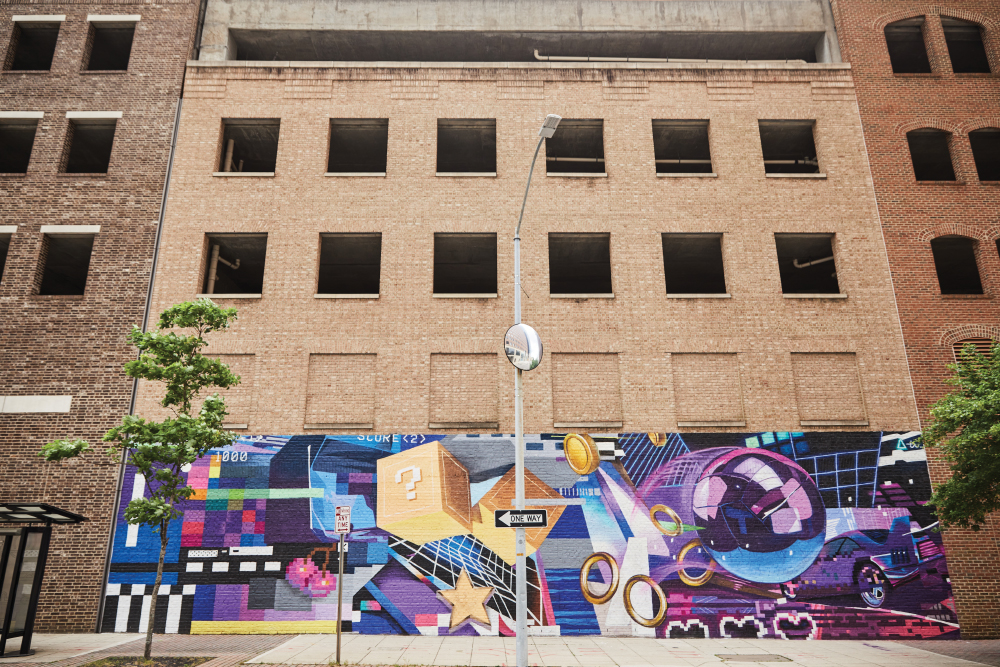
Her work continued to evolve into surrealist renderings of bodies in motion that capture the fluidity of dance, as the human form appears to tumble into, around, and among one another through abstracted limb fragments painted in various shades of purple, blue, and magenta.
White remained in Australia for two years before she felt the lure of home, and after a Christmas visit with family, she decided to return to Raleigh, living and working out of a space in Boylan Heights.
But wanderlust hit again — she “ran away” to Atlanta for six months. “I spent a lot of years thinking I needed to be someplace else,” she says. “I thought I needed to be in L.A., or a bigger city, or around more eclectic people.” It took that move to realize that what she was really looking for was already here. “I woke up one day and I was like, this is all me,” she says. “It’s just bullshit that you’re going to find what you’re looking for anywhere other than where you are, because it’s all up to you.”
So she came back to Raleigh. And here, both her personal work and commissioned projects flourished, her pieces becoming fixtures in the downtown scene. Her 2015 mural, Bacchanalia, lines the walls above the bar at Whiskey Kitchen, and in 2016 she painted Eden, a portrait of a seated man playing the banjo, for Raleigh Raw. Between 2018 and 2020, White completed over a dozen outdoor murals in the Triangle, throughout the United States, and overseas.
White became one of the city of Raleigh’s first commissioned muralists when she created Abstracted Motion, an augmented-reality mural on W. Davie Street, in 2018. The large-scale, 40-foot by 60-foot piece features a series of five dancers who are connected to one another through linked arms and legs. The augmented reality elements of the mural were developed in partnership with Google Fiber and Portland-based design firm Nelson Cash; visitors can view the mural through an app that transforms the subjects into 3D versions of themselves that appear to extend from the mural wall. Using the app, viewers can experience a 360-degree perspective of the piece.
In May, White finished another mural in downtown Raleigh, this one on Wilmington Street. Titled 8-bit to 5G, this one takes a slight departure from her signature figurative style of painting to pay homage to the history of video gaming. It’s an abstracted collage of pixels and symbols that morph together, conjuring memories of TRON, Ms. Pac-Man, Sonic the Hedgehog, and Grand Theft Auto.
The mural, created in a partnership between Subnation Media and the Greater Raleigh Esports Local Organizing Committee, is a nod to the city’s burgeoning video-game industry, which has played a key role in spurring economic growth in Raleigh. “Among many things, public art is what sets a city apart and makes it more memorable,” says Roxanne Lundy of the Downtown Raleigh Alliance, which sponsored the mural in partnership with Red Hat. “We’re lucky to have an artist like Taylor to bring new life to our public spaces. Her murals are eye-catching, technical, and layered in meaning.” (This mural will also have an augmented reality aspect to it, still under development as of press time.)
Even though her mural work is steady, White continues to push herself into new projects. This summer, she opened a self-funded gallery show titled Pursuit of Happiness in the former Art of Style location on Hargett Street. Having her work there is a boon to downtown, says Lundy. “Taylor’s murals and gallery not only inspire but also bring vibrancy to downtown Raleigh,” she says. “The gallery itself is well positioned to complement nearby restaurants, retailers, and businesses along Hargett Street.” Lundy is optimistic about the vital role of art in the district’s recovery. “The success of one brings the success of many. That type of impact is real and makes our community stronger.”
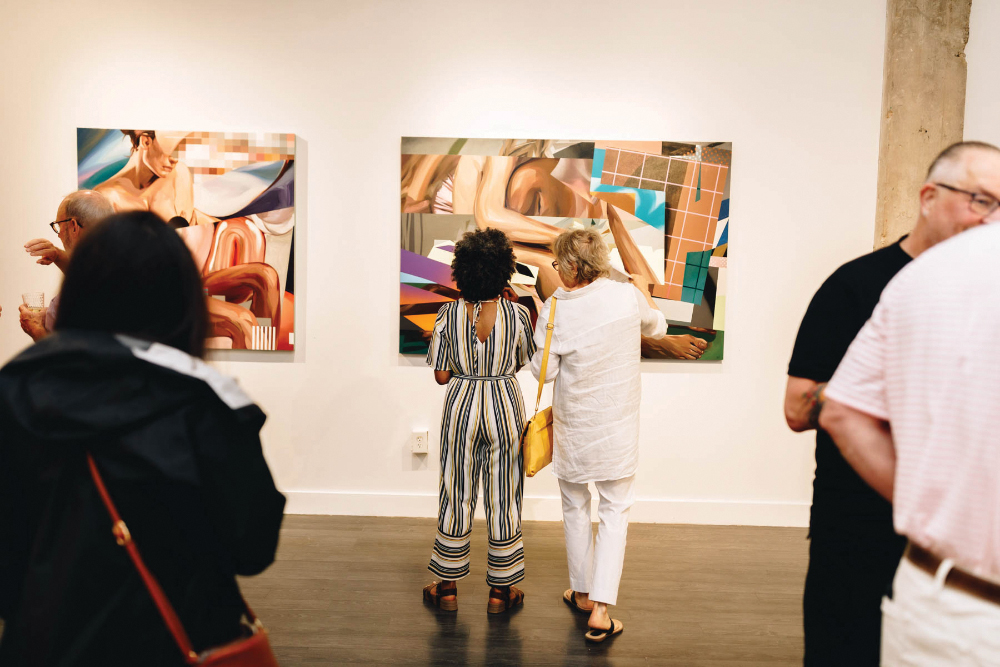
The 24 paintings in Pursuit of Happiness were inspired by the process of transformation. Figurative works feature subjects whose bodies are superimposed with graphic shapes, colorful pixels, and cute emojis. While elements of her mural style are present among the paintings, the additional pop surrealist details make her subjects appear as though they are emerging from or dissolving into pixels and shapes. White’s artist statement contextualizes the work as a function of our collective emergence from the pandemic: “I believe that the past year has pushed us into a transformative state and it is up to us to step forward into that transformation. We are beings with purpose. We are enough; we are completely accepted, and our journey is understood by something more benevolent and complete than what we can perceive as human beings.”
“Taylor’s work is proof that out of a difficult year, creativity will flourish,” says Lundy. For White, this state of grace is the byproduct of a well-traveled journey, filled with experiences that continue to shape her artistic eye, but it’s also a reminder that transformation can begin and end at home, too. While her murals continue to place her artistic stamp on Raleigh, her latest show offers a glimpse into new work that invites viewers to embrace their own post-pandemic state of grace. As she says: “Let’s live life, come out and see art, and celebrate being alive.”
This story originally appeared in our August 2021 issue.

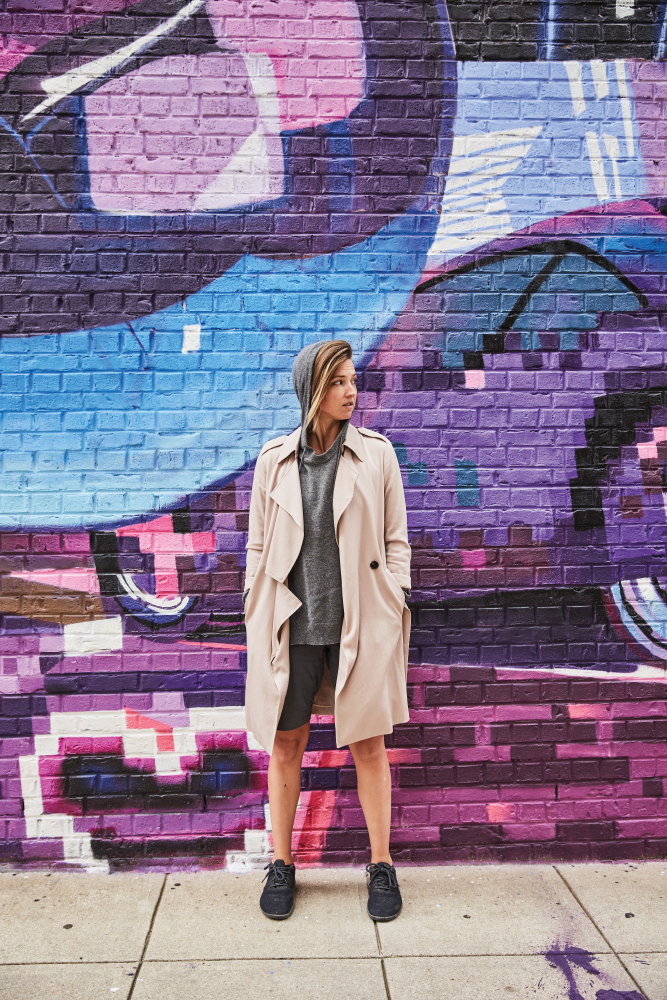
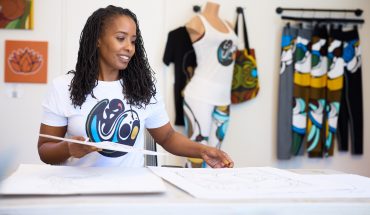
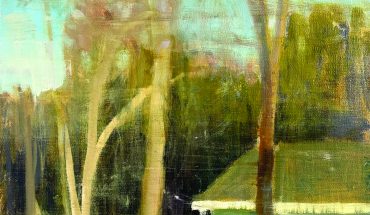
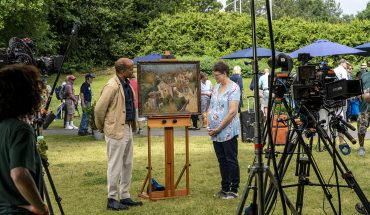
Pingback: 30 Things to Do in August In and Around Raleigh - WALTER Magazine